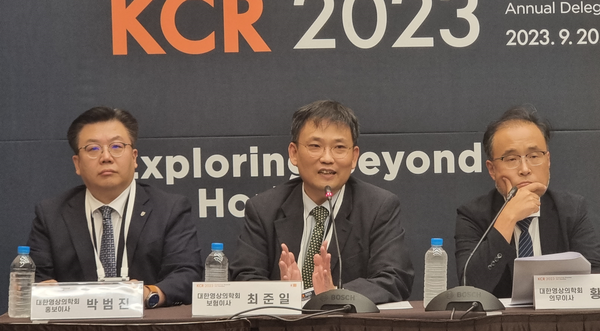Recent advancements in digital health technologies and artificial intelligence (AI) are pushing boundaries in the medical field, but not without concerns.

The Ministry of Health and Welfare (MOHW) reported a plan to temporarily apply health insurance benefits to medical AI and digital treatment devices for up to three years through the Health Insurance Policy Review Committee in July.
The government is receiving opinions about the temporary reimbursement and is preparing specific guidelines for the application of benefits.
However, radiologists are calling for preconditions to curb the reckless expansion.
The Korean Society of Radiology (KSR) first clarified that it is not opposed to the temporary listing itself.
"The issue of insurance coverage for medical AI and digital therapeutic devices is already a hot topic around the world," said Choi Jun-il, the KSR's health insurance committee chair, who is also a professor of radiology at Seoul St. Mary's Hospital. "As radiologists who work closely with medical AI, the KSR is supportive of this coverage discussion in principle."
However, reckless reimbursement can have major adverse effects, and as experts, the KSR has an obligation to provide opinions on appropriate measures, he added.
Choi stressed that this is because the wrong policy can affect the entire healthcare system as well as the public burden.
Choi said that the designation of innovative medical technology requires careful judgment.
In Korea, digital therapeutic devices and AI medical devices are eligible for temporary reimbursement if they are designated as innovative medical devices under the Medical Device Industry Promotion and Innovative Medical Device Support Act, which is controlled by the Ministry of Food and Drug Safety, or as an innovative medical technology under the New Health Technology Assessment System, which is controlled by the National Evidence-based healthcare Collaborating Agency (NECA).
"The difference between innovative medical devices and innovative medical technologies can be understood as the difference between being a medical device or a medical practice," Choi said. "Three AI medical devices in the field of radiology have currently been designated as innovative medical technologies."
While there were not many innovative medical technology designations when the government first discussed the temporary reimbursement, the number of innovative medical device designations is increasing very quickly, Choi added.
According to Choi, the process of innovative medical technology review is so heavily weighted toward the technical evaluation of devices that there is a high chance that technologies with poor medical evidence will be eligible for temporary reimbursement.
Advocating for reform, he emphasized that compensation for AI medical tools should also be restrained to appropriate levels.
"The KSR's opinion is that the compensation for AI medical devices should not exceed 5 percent, which is half of the total imaging test fee that radiologists are paid," Choi said. "While radiologists have multiple responsibilities, including quality control, scheduling, answering attending physician inquiries, and managing side effects of radiological tests, the value of AI software is just a fraction of these responsibilities."
It's imperative to note that AI devices don't bear any responsibility in medical practices, Choi added.
According to Choi, the KSR policy is that compensation for AI medical devices should not exceed 50 percent of the total radiologists' fees.
"Even if AI medical devices are compensated, it should never be used as a reason to reduce physician fees, such as radiologists' and doctors' reading fees or specialist fees," Choi said.
Despite this, the KSR expressed significant reservations about temporary non-reimbursement, emphasizing the gap in perception between the medical community and some businesses.
He warned that companies might charge exorbitant rates, diminishing the role of human doctors.
"In fact, some companies have even proposed plans to charge out-of-pocket costs as high as 30 percent of the test price," Choi said. "This is an unacceptable price for an AI medical device that performs a small fraction of the tasks of a physician's many roles."
However, if it is designated as a temporary non-reimbursed product, there is no real mechanism to control the price, he added.
To prevent potential misuse, Choi said that the KSR proposed four guidelines for non-payment inclusions -- clear indications for AI medical devices, limited non-payment approval, consideration of a mechanism for non-payment price control, and a plan to mandatorily require approval from radiologists before making claims.
"The KSR supports in principle for temporarily approving health insurance or non-payment for appropriate AI medical technologies," Choi said. "However, we are opposed to policies that are not based on medical science, but on industrial ideas, where these technologies are rewarded unconditionally just because they are new."
The KSR hopes that the opinions expressed by the society will be fully reflected in policy to avoid such absurdities, Choi added.

